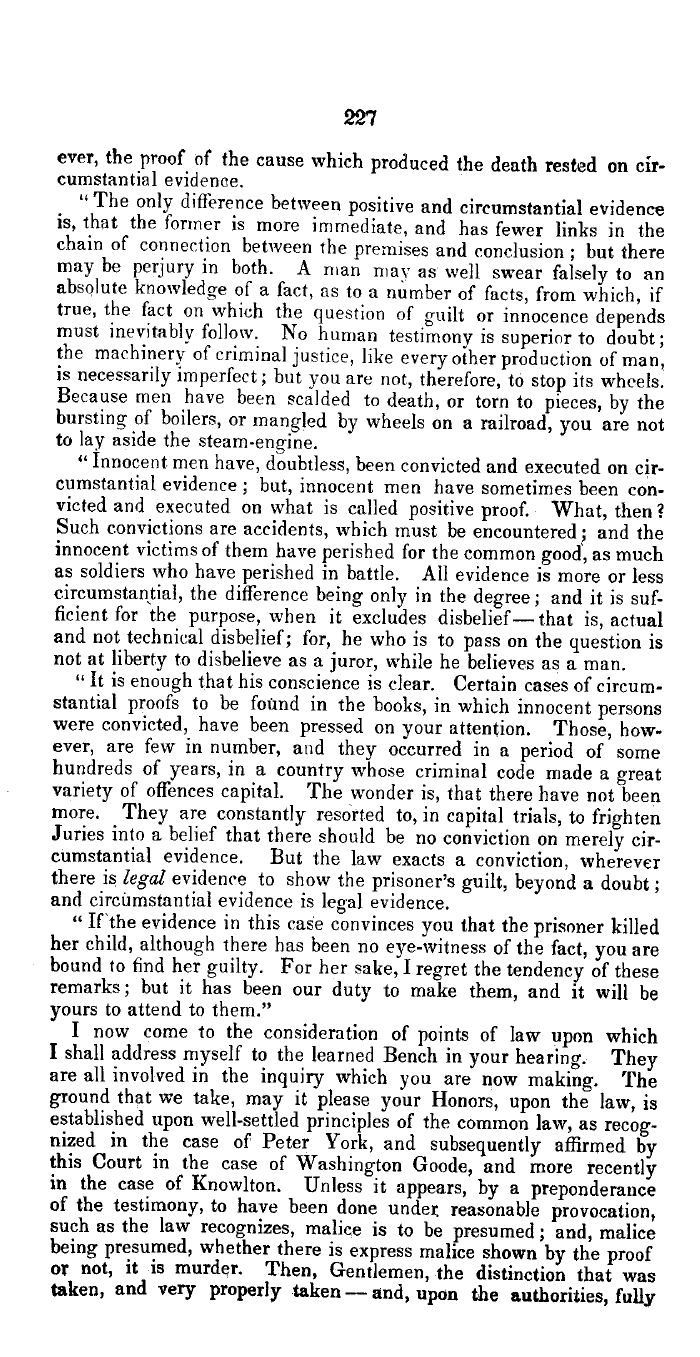|
227
ever, the proof of the cause which produced the death rested on cir-
cumstantial evidence.
"The only difference between positive and circumstantial evidence
is, that the former is more immediate, and has fewer links in the
chain of connection between the premises and conclusion ; but there
may be perjury in both. A man may as well swear falsely to an
absolute knowledge of a fact, as to a number of facts, from which, if
true, the fact on which the question of guilt or innocence depends
must inevitably follow. No human testimony is superior to doubt;
the machinery of criminal justice, like every other production of man,
is necessarily imperfect; but you are not, therefore, to stop its wheels.
Because men have been scalded to death, or torn to pieces, by the
bursting of boilers, or mangled by wheels on a railroad, you are not
to lay aside the steam-engine.
" Innocent. men have, doubtless, been convicted and executed on cir-
cumstantial evidence ; but, innocent men have sometimes been con-
victed and executed on what is called positive proof. What, then ?
Such convictions are accidents, which must be encountered; and the
innocent victims of them have perished for the common good, as much
as soldiers who have perished in battle. All evidence is more or less
circumstantial, the difference being only in the degree; and it is suf-
ficient for the purpose, when it excludes disbelief-that is, actual
and not technical disbelief; for, he who is to pass on the question is
not at liberty to disbelieve as a juror, while he believes as a man.
" It is enough that his conscience is clear. Certain cases of circum-
stantial proofs to be found in the books, in which innocent persons
were convicted, have been pressed on your attention. Those, how-
ever, are few in number, and they occurred in a period of some
hundreds of years, in a country whose criminal code made a great
variety of offences capital. The wonder is, that there have not been
more. They are constantly resorted to, in capital trials, to frighten
Juries into a belief that there should be no conviction on merely cir-
cumstantial evidence. But the law exacts a conviction, wherever
there is legal evidence to show the prisoner's guilt, beyond a doubt;
and circumstantial evidence is legal evidence.
'° If'the evidence in this case convinces you that the prisoner killed
her child, although there has been no eye-witness of the fact, you are
bound to find her guilty. For her sake, I regret the tendency of these
remarks; but it has been our duty to make them, and it will be
yours to attend to them."
I now come to the consideration of points of law upon which
I shall address myself to the learned Bench in your hearing. They
are all involved in the inquiry which you are now making. The
ground that we take, may it please your Honors, upon the law, is
established upon well-settled principles of the common law, as recog-
nized in the case of Peter York, and subsequently affirmed by
this Court in the case of Washington Goode, and more recently
in the case of Knowlton. Unless it appears, by a preponderance
of the testimony, to have been done under reasonable provocation,
such as the law recognizes, malice is to be presumed; and, malice
being presumed, whether there is express malice shown by the proof
or not, it is murder. Then, Gentlemen, the distinction that was
taken, and very properly .taken-and, upon the authorities, fully
|

